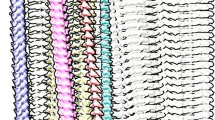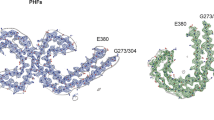Abnormal fibrils from scrapie-infected brain (original) (raw)
Summary
Abnormal fibrillary structures, designated “scrapie-associated fibrils” (SAF), have been observed using negative stain techniques in subfractions of brains from scrapie-affected animals. SAF have been observed in all combinations of strain of scrapie agent and strain or species of host examined, regardless of their histopathology, in particular the presence or absence of amyloid plaques. SAF consist either of two or four filaments. They are morphologically dissimilar to the normal brain fibrils — microtubules, neurofilaments, glial filaments, and F actin. However, SAF do bear a resemblance to amyloid.
Access this article
Subscribe and save
- Get 10 units per month
- Download Article/Chapter or eBook
- 1 Unit = 1 Article or 1 Chapter
- Cancel anytime Subscribe now
Buy Now
Price excludes VAT (USA)
Tax calculation will be finalised during checkout.
Instant access to the full article PDF.
Similar content being viewed by others

RNA as a component of scrapie fibrils
Article Open access 29 February 2024

References
- Amos LA (1979) Structure of microtubules. In: Roberts K, Hyams JS (eds) Microtubules. Academic Press, London, pp 1–64
Google Scholar - Boeré H, Ruinen L, Scholten JH (1965) Electron-microscopic studies on the fibrillar component of human splenic amyloid. J Lab Clin Med 66:943–951
Google Scholar - Chandler RL (1963) Experimental scrapie in the mouse. Res Vet Sci 4:276–285
Google Scholar - Cohen RS, Blomberg F, Berzins K, Siekevitz P (1977) The structure of postsynaptic densities isolated from dog cerebral cortex. I. Overall morphology and protein composition. J Cell Biol 74:181–203
Google Scholar - Dickinson AG, Fraser H (1977) The pathogenesis of scrapie in inbred mice: an assessment of host control and response, involving many strains of agent. In: ter Meulen V, Katz M (eds) Slow virus infections of the central nervous system. Springer, New York, pp 3–13
Google Scholar - Dickinson AG, Fraser H, Bruce M (1979) Animal models for the dementias. In: Glen AIM, Whalley LJ (eds) Alzheimer's disease. Early recognition of potentially reversible deficits. Churchill Livingstone, Edinburgh London New York, pp 42–45
Google Scholar - Flament-Durand J, Couck AM (1979) Spongiform alteration in brain biopsies of presenile dementia. Acta Neuropathol (Berl) 46: 159–162
Google Scholar - Forer A (1978) Electron microscopy of actin. In: Hayat MA (ed) Principles and techniques of electron microscopy, vol 9. van Nostrand Reinhold, New York, pp 126–174
Google Scholar - Fraser H (1976) The pathology of natural and experimental scrapie. In: Kimberlin RH (ed) Slow virus diseases of animals and man. North Holland, Amsterdam New York, pp 209–241
Google Scholar - Fraser H (1980) Neuropathology of Scrapie: The precision of the lesions and their diversity. In: Prusiner SB, Hadlow WJ (eds) Slow transmissible diseases of the nervous system, vol 1. Academic Press, New York, pp 387–406
Google Scholar - Glenner GG (1980) Amyloid deposits and amyloidosis. N Engl J Med 302:1283–1292
Google Scholar - Glenner GG, Canes ED, Bladen HA, Linke RP, Termine JD (1974) \-pleated sheet fibrils. A comparison of native amyloid with synthetic protein fibrils. J Histochem Cytochem 22:1141–1158
Google Scholar - Glenner GG, Page D, Iserski C, Harada M, Cuatrecasas P, Canes ED, DeLellis RA, Bladen HA, Keiser HR (1971) Murine amyloid fibril protein: Isolation purification, and characterization. J Histochem Cytochem 19:16–28
Google Scholar - Iqbal K, Wisniewski H (1979) Neurofilament proteins: Effect of ionic strength and a calcium chelator. Trans Am Soc Neurochem 10:168
Google Scholar - Kim H, Binder LI, Rosenbaum JL (1979) The periodic association of MAP2 with brain microtubules in vitro. J Cell Biol 80:266–276
Google Scholar - Kimberlin RH (1976) Biochemical and behavioral changes in scrapie. In: Kimberlin RH (ed) Slow virus diseases of animals and man. North Holland, Amsterdam New York, pp 307–323
Google Scholar - Kimberlin RH, Walker CA (1977) Characteristics of a short incubation model of scrapie in the golden hamster. J Gen Virol 34:295–304
Google Scholar - Krishnan N, Kaiserman-Abramof IR, Lasek RJ (1979) Helical substructure of neurofilaments isolated from_Myxicola_ and squid giant axons. J Cell Biol 82:323–335
Google Scholar - Oppenheimer DR (1975) Pathology of transmissible and degenerative diseases of the nervous system. In: Illis LS (ed) Viral diseases of the central nervous system. Williams and Wilkins, Baltimore, pp 161–174
Google Scholar - Outram GW (1976) The pathogenesis of scrapie in mice. In: Kimberlin RH (ed) Slow virus diseases of animals and man. North Holland, Amsterdam New York, pp 325–357
Google Scholar - Rueger DC, Huston JS, Dahl D, Bignami A (1979) Formation of 100 Å filaments from purified glial fibrillary acid protein in vitro. J Mol Biol 135:53–68
Google Scholar - Schlaepfer WW (1977) Immunological and ultrastructural studies of neurofilaments isolated from rat peripheral nerve. J Cell Biol 74:226–240
Google Scholar - Shelanski ML, Albert S, Devries GH, Norton WT (1971) Isolation of filaments from brain. Science 174:1242–1245
Google Scholar - Shelanski ML, Gaskin F, Cantor CR (1973) Microtubule assembly in the absence of added nucleotides. Proc Natl Acad Sci USA 70:765–768
Google Scholar - Spudich JA, Watt S (1971) The regulation of rabbit skeletal muscle contraction. J Biol Chem 246:4866–4871
Google Scholar - Spurr AR (1969) A low viscosity epoxy resin embedding medium for electron microscopy. J Ultrastruct Res 26:31–43
Google Scholar - Whittaker VP (1969) The synaptosome. In: Lajtha A (ed) Handbook of neurochemistry, vol 2. Plenum, New York, pp 327–364
Google Scholar - Wisniewski HM (1979) Neurofibrillary and synaptic pathology in senile dementias of the Alzheimer's type. In: Glen AIM, Whalley LJ (eds) Alzheimer's disease. Early recognition of potentially reversible deficits. Churchill Livingstone, Edinburgh London New York, pp 7–16
Google Scholar - Wisniewski HM, Bruce ME, Fraser H (1975) Infectious etiology of neuritic (senile) plaques in mice. Science 190:1108–1110
Google Scholar - Wisniewski HM, Terry RD (1973) Morphology of the aging brain, human and animal. Prog Brain Res 40:167–186
Google Scholar
Author information
Authors and Affiliations
- New York State Institute for Basic Research in Mental Retardation, 1050 Forest Hill Road, 10314, Staten Island, NY, USA
P. A. Merz, R. A. Somerville, H. M. Wisniewski & K. Iqbal
Authors
- P. A. Merz
You can also search for this author inPubMed Google Scholar - R. A. Somerville
You can also search for this author inPubMed Google Scholar - H. M. Wisniewski
You can also search for this author inPubMed Google Scholar - K. Iqbal
You can also search for this author inPubMed Google Scholar
Rights and permissions
About this article
Cite this article
Merz, P.A., Somerville, R.A., Wisniewski, H.M. et al. Abnormal fibrils from scrapie-infected brain.Acta Neuropathol 54, 63–74 (1981). https://doi.org/10.1007/BF00691333
- Received: 24 October 1980
- Accepted: 28 November 1980
- Issue Date: March 1981
- DOI: https://doi.org/10.1007/BF00691333
